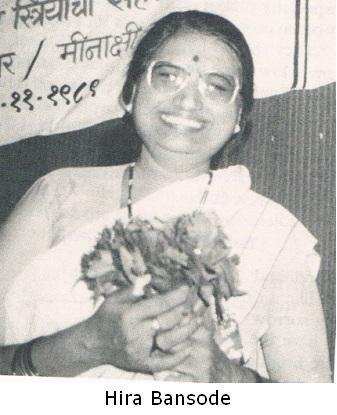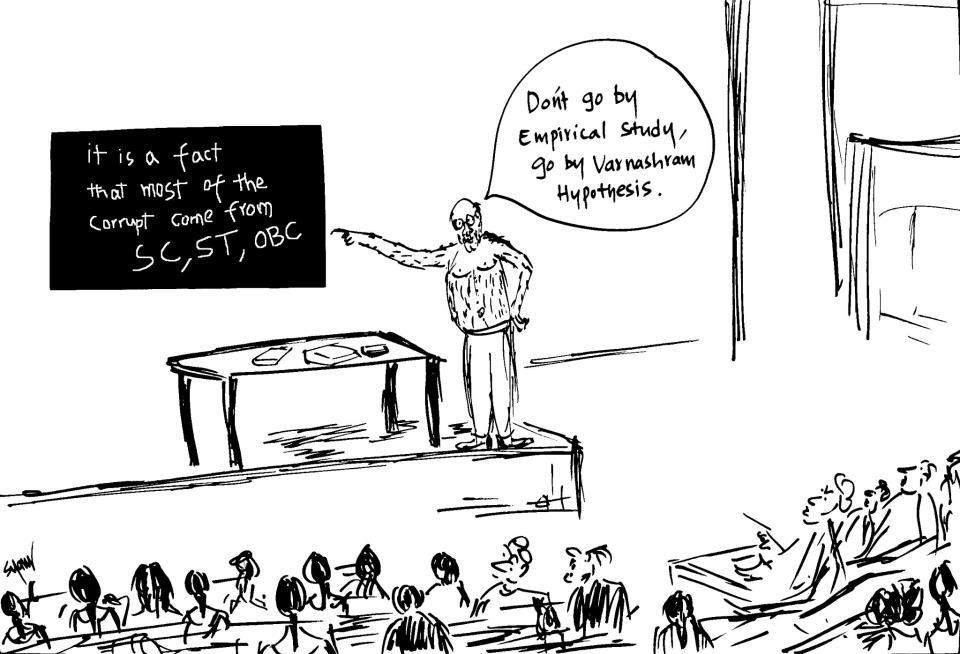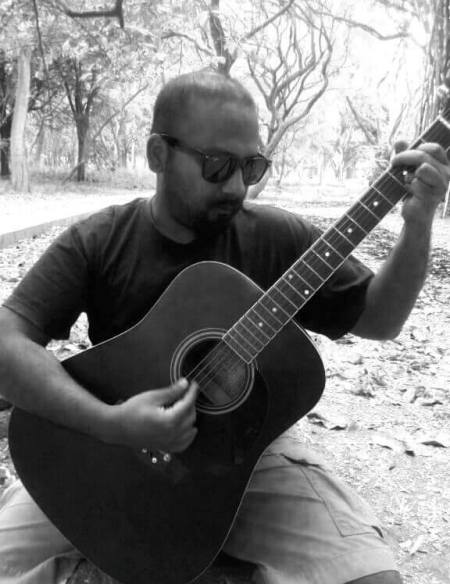Continued from here.
Anu Ramdas
Hira Bansode in her poem Ghulam (‘Slave’) writes:
 Where a woman in her youth is dried up by tradition
Where a woman in her youth is dried up by tradition
she is confined all her life like a stunted tree
she remains in the shadow of someone else’s light
In that country a woman is still a slave
~~~
‘We have seen Dalit intellectuals fulminate rightly against an unmarked and global feminism, and now it seems important that they examine their own complicity with the violent politics of caste patriarchy and masculinity‘ – V Geetha.
The above quote is also from the same article in The Hindu to which I refer, in ‘My Man‘. This statement about dalit intellectuals commenting on feminism is surely backed by solid evidence, given that it is being made to the national audience of this newspaper. So where exactly have these dalit intellectuals made these ‘fulminations’? Who are they? What are the citations? If this author is referring to dalit intellectuals’ interventions in Indian languages, one wonders why such texts have not been translated and made available, as the English-reading audience of this newspaper is being referred to the existence of this discourse?
I don’t know what the readers make out of this part of the sentence “We have seen Dalit intellectuals fulminate rightly against an unmarked and global feminism,” but to my mind, it is referring to some intervention by dalit intellectuals to which the readers are neither given a background nor clues to locate the source.
 Consider its contents at their face value: The struggle against caste supremacy is taking issue with the struggle against patriarchal supremacy! Pretty astounding, isn’t it? One expects near total compatibility in these two historical struggles, so what gives? In other words, what is caste, and what is patriarchy? And what are their struggles about? Caste and patriarchy are two irrevocably conjoined dominator cultures in the context of South Asia.
Consider its contents at their face value: The struggle against caste supremacy is taking issue with the struggle against patriarchal supremacy! Pretty astounding, isn’t it? One expects near total compatibility in these two historical struggles, so what gives? In other words, what is caste, and what is patriarchy? And what are their struggles about? Caste and patriarchy are two irrevocably conjoined dominator cultures in the context of South Asia.
Hira’s verse quoted above should leave no doubt in anyone’s mind that it is addressed to the universal, unmarked woman, a call for the liberation of women anywhere.
However, when Jupaka Subhadra, says:
my kongu rag that sticks to me
in work and song, in crisis and comfort,
like the filth that clings to my feet, the companion
of my life path…slaving like the washerman’s stone,
when does my perspiring kongu find the time for rest?
She’s not the patchy pallu that stands guard over my head
nor the hobbling stone… over my breast
Then, the particulars of the high and low, the specifics of womens’ differences across caste and class, the void between the kongu and the pallu gets detailed out for us.
 Encapsulated between Hira and Jupaka’s short verses lies the contemporary dalitbahujan women’s struggle for women’s liberation in a caste stratified society. Dalits, who for so long have been elaborating about the interlocking nature of caste and patriarchy, naturally repose tremendous faith in feminist struggles of all hues. What does not escape them however, is the misuse of feminism to maintain status quo of caste supremacy.
Encapsulated between Hira and Jupaka’s short verses lies the contemporary dalitbahujan women’s struggle for women’s liberation in a caste stratified society. Dalits, who for so long have been elaborating about the interlocking nature of caste and patriarchy, naturally repose tremendous faith in feminist struggles of all hues. What does not escape them however, is the misuse of feminism to maintain status quo of caste supremacy.
What are being referred to as fulminations here are instances where it has been pointed out that the refusal to engage with caste while attempting gender equity in a caste stratified society is self-defeating, and devastatingly disruptive for feminist struggles of women from the lower castes, untouchable castes and adivasis, I guess.
The term ‘fulmination’, strictly read means verbal attacks, exploding verbal attacks to be more precise. Fulminations need not name the authors or have citations, I guess.
Let me take a moment to unpack what lies in the word fulmination here: The article prefaces with advice to subaltern men and ends with advice to dalit intellectuals (men, women or both?). Why have these intellectuals referred to here, not converted their verbal disagreements with feminism into readable, reproducible texts and put them into the public sphere? If these dalit intellectuals are academics, one can safely assume there is availability of academic and other resources to create such texts. Or if they are public intellectuals they’ve had access to media platforms where they have managed to convey the same.
 As someone who has been archiving dalit articulations for the express purpose of digital documentation and recirculation among dalitbahujan readers, off the top of my head, I can list most of the articles and video recordings that are freely available on the web that have been authored by dalit intellectuals, laying out their differences with mainstream feminism. They are mostly essays or brief speeches by dalit women for blogs and magazines; spaces created by activists and students, done without any access to institutional resources. That is, sporadic knowledge production at the frayed margins comprising of a few inspiring essays and poetry penned largely by dalit women like Ruth Manorama, Rajni Tilak, Cynthia Stephen, Indira Jalli, Swathy Margaret, Sudharani and others in English; Gogu Shymala, Rekha Raj and several women writers and poets in many Indian languages. The one significant text on this topic that did come out of academic backing is the one by Prof Gopal Guru, 17 years ago.
As someone who has been archiving dalit articulations for the express purpose of digital documentation and recirculation among dalitbahujan readers, off the top of my head, I can list most of the articles and video recordings that are freely available on the web that have been authored by dalit intellectuals, laying out their differences with mainstream feminism. They are mostly essays or brief speeches by dalit women for blogs and magazines; spaces created by activists and students, done without any access to institutional resources. That is, sporadic knowledge production at the frayed margins comprising of a few inspiring essays and poetry penned largely by dalit women like Ruth Manorama, Rajni Tilak, Cynthia Stephen, Indira Jalli, Swathy Margaret, Sudharani and others in English; Gogu Shymala, Rekha Raj and several women writers and poets in many Indian languages. The one significant text on this topic that did come out of academic backing is the one by Prof Gopal Guru, 17 years ago.
Does one get the enormity of imbalance in the way this discourse is happening? And what it says about the systemic exclusion of dalit/adivasi/bahujan intellectuals (particularly women) in accessing resources, audiences and spaces for knowledge production?
130 years since Tarabai Shinde wrote ‘Stree Purush Tulana‘, a feminist crtique of patriarchy in a caste society. Two decades since dalit women articulated for an intersectional approach to feminism in a society like ours. Fulminations? Or is it the brutal silencing of dalitbahujan women’s knowledge production?
Knowledge from the margins is always invested in transforming society by upending the very roots of injustice and inequality. And if feminism as elaborated by upper caste men and women is being deconstructed — what a pity that it remains as uncitable fulminations.
This is not just to reiterate the chronic non-availability of resources for dalit, adivasi and bahujan women to make their views on feminism or anything else be known and discussed as valid arguments, but it is to expose the cool elevation of dalit intellectuals to an imaginary access to resources equal to upper caste feminists, while reporting from a platform that is immediately accessed by the national audience of The Hindu. Casually implying that we are now playing intellectual volley ball on a level playing ground. Unconscious distortion perhaps, but distortion nevertheless.
 Dalits may point out elitist feminism as an emerging power structure that further disempowers women in a caste society. This is just ‘one’ aspect of their commentary about a dysfunctional and ugly society. Insights from dalit communities like other historically marginalized groups provide the most powerful interventions to mitigate dominator cultures. Because their analyses slice through numerous cross-linking matrices of power structures which are often invisible to the ones wielding privilege. Intellectuals from within these communities attempt to facilitate the crystallization of these insights from the community into textual formats. This process is again fraught with difficulties as it includes dodging co-option, avoiding dilution and most often encountering the ‘conspiracy of silence’. Apart from the usual obstacles to resources and spaces for analysis, to develop and communicate critical consciousness about the struggle against caste and patriarchy.
Dalits may point out elitist feminism as an emerging power structure that further disempowers women in a caste society. This is just ‘one’ aspect of their commentary about a dysfunctional and ugly society. Insights from dalit communities like other historically marginalized groups provide the most powerful interventions to mitigate dominator cultures. Because their analyses slice through numerous cross-linking matrices of power structures which are often invisible to the ones wielding privilege. Intellectuals from within these communities attempt to facilitate the crystallization of these insights from the community into textual formats. This process is again fraught with difficulties as it includes dodging co-option, avoiding dilution and most often encountering the ‘conspiracy of silence’. Apart from the usual obstacles to resources and spaces for analysis, to develop and communicate critical consciousness about the struggle against caste and patriarchy.
 Dalit women are not criticizing ‘global feminism’, they critique upper caste men and women’s understanding of feminism. Some of them draw from Black, Latino and African feminism which has become available to them, thanks to, largely free of caste controls, the web. But most significantly they draw from the anti-caste radical feminists; Jyotiba Phule, Savitribai, Tarabai and the poet predecessors of Hira Bansode and Jupaka Subhadra, going back to the medieval times. On an everyday basis they draw from the feminism practiced by Lakshmis and Shanmugams.
Dalit women are not criticizing ‘global feminism’, they critique upper caste men and women’s understanding of feminism. Some of them draw from Black, Latino and African feminism which has become available to them, thanks to, largely free of caste controls, the web. But most significantly they draw from the anti-caste radical feminists; Jyotiba Phule, Savitribai, Tarabai and the poet predecessors of Hira Bansode and Jupaka Subhadra, going back to the medieval times. On an everyday basis they draw from the feminism practiced by Lakshmis and Shanmugams.
Education, reservation and sheer intellectual hardwork either as individual factors or all together could not break the shackles of caste for dalitbahujan women intellectuals to lead or participate as equal partners in the feminist discourse of this country. The numerous intellectual careers laid to waste, the intellectual loss to feminism in the way these women were alienated in contemporary times has only reinforced for us the knowledge that the battle against patriarchy is simultaneously a battle against caste.
What I have traced here so far are the faint contours of the fragile terrain in which Dalit women’s articulations are created and nervously hedged around. Imagine the terrain on which Adivasi and lower shudra women’s knowledge production and erasure is situated upon – these processes lie hidden in darkness as of now.
 Given this suffocating history and continuing reality, women from the marginalized communities are beginning to take advantage of technology to create unmediated spaces on the web for self expression. They are redrawing the feminist discourse for it to be truly effective for the large majority of women, instead of a select few belonging to select castes. This has set off some reactions from mainstream feminists and scholars. In the next article I will focus on one such reaction: the taking of deep offense at our articulation that names the upper caste location of mainstream feminists and scholars.
Given this suffocating history and continuing reality, women from the marginalized communities are beginning to take advantage of technology to create unmediated spaces on the web for self expression. They are redrawing the feminist discourse for it to be truly effective for the large majority of women, instead of a select few belonging to select castes. This has set off some reactions from mainstream feminists and scholars. In the next article I will focus on one such reaction: the taking of deep offense at our articulation that names the upper caste location of mainstream feminists and scholars.
(When I use the term feminism or feminist struggles in the context of marginalized women with long histories of resistance against power and oppression, I mean the inherent capacity to recognize and the willingness to confront patriarchal norms)
~~~
To be continued.
Courtesy: Images from the web and from the personal albums of Sandali Thakur and Manju Rao.










